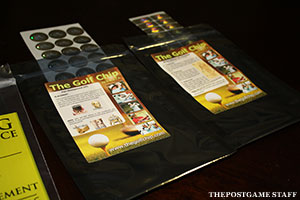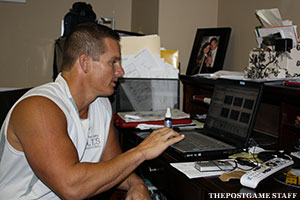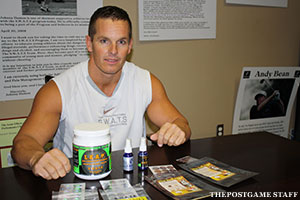
Last July, six months before his team won college football's national championship, Auburn safety Zac Etheridge held a players-only meeting in his living room. Just a few months removed from a severe neck injury that left him lying motionless on the field at Jordan-Hare Stadium, Etheridge wanted to talk to his teammates about a new technology he felt helped him heal.

They are called "chips" -- tiny holographic patches worn on the skin at Chinese acupuncture points that, according to the company that supplied them to Etheridge, Sports With Alternatives To Steroids (S.W.A.T.S.), help the body maintain and replenish its energy supply.
If S.W.A.T.S. sounds familiar to you, it should. The company's founder, Mitch Ross, has been in the news recently for another of his controversial products -- The Ultimate Spray. It's a supplement supposedly made from deer velvet antler which is touted to contain a growth hormone banned by every major professional sports league. Ross had ties to several coaches in the NFL and many players, but the league recently informed them they had to end their relationships with the supplement company.
But his other major product, these chips, have not been touted as containing any banned substance, and that's what Etheridge says he used during his rehabilitation. When he was first injured, tearing ligaments in his neck and cracking his fifth vertebrae while making a tackle, doctors didn't know if he'd ever take the field again. Eight months later, he was cleared to play. He credits the chips, in part, for his quick recovery.
Etheridge wanted his teammates to hear about the chips, so he arranged for Christopher Key, Ross’s partner in S.W.A.T.S., to address the group. Key says roughly 60 Auburn players were present, including nearly all of the starters. Etheridge says his teammates were impressed enough to try the chips during the season. When Auburn beat Oregon 22-19 in the BCS title game, many of the Auburn players were wearing the chips in the form of a band wrapped around their wrists, according to Etheridge's account.
"A lot of us wore them throughout our championship run and we won the championship," Etheridge says in a S.W.A.T.S. video. "Compared to last year, fourth quarter, we were gassed. And those bands, we felt like that fourth quarter was the first quarter.”
Two other Auburn players, Mario Fannin and Mike Blanc, give similar testimonials in videos of their own. And so do some NFL players. When reached on the phone recently, Cincinnati Bengals safety Roy Williams said he uses them even in the off-season. They've become a "ritual" for golfer Mark Calcavecchia.
So who is Mitch Ross? How did a former bodybuilder from Alabama with a tiny office, a huge RV, a youthful face and boundless energy gain the trust of important people in and around NFL locker rooms and influence a National Championship? And what are these "chips"?
"I think you may be interested in what I've been doing for the past four years," said Ross. "I think it's going to blow your mind."
Mitch Ross grew up in Douglas County, Ga., just outside of Atlanta. After graduating high school, he got into personal training and joined a gym in 1985. That's where he was first introduced to the world of bodybuilding and the culture that came with it.
"The guy behind the counter sold steroids right out of the refrigerator," Ross recalled. "I used a little back in the day when I first started. You go to a gym, you follow what everybody else is doing."
This was before the government outlawed steroids and passed the Anabolic Steroid Control Act of 1990. Still, Ross didn't like the side effect and says he quit using them.
He eventually moved to Birmingham, Ala., where he helped overhaul several gyms in the area. It was there where he was approached by an undersized weightlifter in his 50s. The man was, in Ross' words, "an MLMer" -- or a Multi-Level-Marketer, which is someone who not only sells a product, but recruits others to do the same.
Ross sighed and asked, "What do you got for me now?"
What the man presented to him would change Ross' life.

They were little patches, meant to be worn on the skin at Chinese acupuncture points like the wrists and upper chest. LifeWave, the company that makes them, claims the patches provide energy to the body through homeopathic mechanisms.
"Specific wavelengths of light are capable of triggering specific biochemical responses within the human body," explains David Schmidt, founder of LifeWave. "For example, you go out in the sun and a wavelength of light causes the body to make Vitamin D."
Ross liked the idea, but hated the system the company used to sell the patches. So when there was dissension at LifeWave, he decided to branch off with some of the company's top people and take the technology in a different direction.
Ross and his partners say they figured out a way to identify the frequency of any nutrient and embed it into their own patches. In theory, the human energy field can recognize the frequencies and cause the same chemical reaction inside the body as if those nutrients had been eaten.
This means that instead of an athlete having to eat a banana to get potassium to prevent cramping in the middle of a game, Ross says, an athlete could have the frequency for potassium on his or her skin in the chip and the body would respond as if it had been ingested.
Ross says he helped create a formula for several over-the-counter nutrients athletes need while performing. The frequencies for those nutrients, Ross says, were then stored on the chips inside a hologram.
"They needed me to develop the athletic part of all this," he says. "The arm of making this a household name and legit."
Eventually, Ross began selling his own patches through a company he founded in 2005, S.W.A.T.S. (Sports With Alternatives to Steroids). He created two types of chips -- performance chips and pain chips, which several injured athletes including Etheridge claim helped them heal.
"(These chips are) the most enhancing product out there," Ross says.
The next step was to get S.W.A.T.S. some publicity, and how better to do that than to get the endorsement of some high-profile athletes?
In 2008, Ross went to the NFL Combine in Indianapolis. He spent time in hotel lobbies and eagerly introduced himself to anyone he recognized and some he didn't. That's where he first met Hue Jackson, then an assistant coach with the Baltimore Ravens, and Anthony Lynn, an assistant with the Cleveland Browns.
Both coaches were unsure of Ross and the technology. It took several months of texting before Ross would gain their trust. But it was an unexpected display on the college level that jolted S.W.A.T.S. into NFL locker rooms.

On September 27, 2008, No. 10 Alabama went on the road to take on No. 3 Georgia.
"Tonight Alabama is going to triple chip against Georgia and beat the ever living s--- out of them," Ross texted Lynn. "And the chips are going to be the reason why."
A few months earlier, Ross says he passed along his chips to some University of Alabama student-athletes. One of those was star running back Glen Coffee, who says he did try them. According to Ross, some members of the Crimson Tide football team were wearing the chips the night they took on Georgia, which went into the season ranked No. 1. (Reached by phone, Alabama sports information director Jeff Purinton told ThePostGame.com, "Alabama has nothing to do with this guy.")
By halftime, the Crimson Tide was rolling over Georgia, 31-0.
"Okay prophet," Lynn texted back to Ross, "you have my attention."
(Reached by phone, Lynn confirmed this account to ThePostGame.com.)
When the Browns next played, on a Monday night against the undefeated New York Giants, several players wore the chips, according to Lynn. Cleveland, 1-3 going into the game, beat the reigning Super Bowl champs, 35-14.
It took Jackson slightly longer to come around, but he did invite Ross to Baltimore that fall. The coach wouldn't allow Ross to distribute any of his products to players, but Jackson himself did.
"He walked me into that locker room," Ross says. "I spent four or five hours in there."
Among those interested in the chips, according to Ross, was all-pro linebacker Ray Lewis. Neither he nor his agent replied to several requests for comment, but teammate Brendon Ayanbadejo, reached by phone recently, said of Lewis, "I know he uses the S.W.A.T.S. and he's been using them ever since I've been in Baltimore. And I know he uses them in a similar way that I use the LifeWave patches."
According to Jackson, Lewis' positive response to the chips got a reaction throughout the Ravens' locker room. "If I didn't have [the chips]," Jackson explained, "people would be like, 'Where are they?'"
The Ravens went from 5-11 in 2007 to 11-5 a year later. Ross credits the chips. Jackson, who has since cut ties with S.W.A.T.S., agreed.
"Do I think it made a difference in Baltimore?" Jackson said in an interview prior to him cutting ties with Ross. "Yeah, I do. The greatest player to ever wear a Baltimore Ravens uniform is wearing them. That proof is in that pudding."
Bengals safety Roy Williams told ThePostGame.com that he wore the chips during the 2010 season and, when reached by phone recently, said, "I got 'em on right now."
The strongest testimonials, however, come from outside the NFL.
Champions Tour member Mark Calcavecchia says he heard about the chips from fellow golfer Ken Green, who used them to recover from a serious RV accident last year.
"I'm still not entirely sure what they do, but at the time I put 'em on, I couldn't bend my right wrist forward or backward," Calcavecchia told ThePostGame.com in a February phone interview. "Slowly but surely, my wrist started getting better. I put 'em on my elbow, back, right shoulder, bottom of my heels, on my neck. Anywhere that aches. It's become a ritual. It's completely healed my wrist.”

Motocross star Mike Metzger says he used both the chips and The Ultimate Spray -- another Ross product -- to recover from a crash last May in which he shattered his right elbow into eight pieces and broke his right femur. Two months before the accident, Metzger met Ross at a Supercross event in Jacksonville, Fla., and Ross sold him on S.W.A.T.S.
"I was really having a hard time with pain and once I started putting chips on my back, the pain went away," Metzger said. "And then using the spray, it felt like it rejuvenated my body."
Ten weeks after his accident, Metzger competed in the XGames, making it all the way to the Speed and Style finals.
But what truly sold Metzger on Ross and his products had nothing to do with riding or injuries, but what happened after he began using The Ultimate Spray.
"I used to chew tobacco when I was younger," he says, "and I had some pretty bad receding gums on my lower gum line. Within two weeks, I felt my teeth getting stronger and then my gums started growing back."
Ross' dream was being played out. He had the ear of some big-name athletes -- getting the attention from the sporting world he so craved. But the strongest evidence for his chips wouldn't come until 2011.
The University of Alabama sent a letter to Ross in 2009 ordering him to avoid contact with all of its student-athletes. So he decided to leave the college ranks and focus on the NFL.
Enter Christopher Key. He met Ross through the personal training business in Birmingham. Key has a degree in kinesiology and has owned gyms. Ross introduced him to the chips in 2008, but Key was skeptical. "I thought he was crazy like everyone else did," Key says. But after researching and testing them, he got on board. Key, an Alabama grad, became the college arm of S.W.A.T.S. Key pitched the chips under a different name, "Mojo," and says he tried to get his alma mater to consider officially using the chips as a team, but to no avail.
So Ross and Key decided to show Alabama the hard way that the technology worked by taking it to the Crimson Tide's biggest rival.
Key says an Auburn booster introduced him to several team doctors. After hearing about the technology, they approved the use on several players, including Zac Etheridge. That was in July 2010 -- and the players-only meeting soon followed. Many players began wearing the chips. Auburn kept winning.
A half-dozen calls to Auburn officials were not returned.
In his video, Mario Fannin said of the chips, "my performance progressed tremendously."
And in preparation for the 2011 NFL Combine, a number of Auburn players, including Fannin, wore them during workouts.
"I went into the combine, never ran a 4.3," Fannin said in a video provided by S.W.A.T.S. "So the combine came and [I] ran the 40 in a 4.3. They really do work. My bench press, I've only gotten 17 while being here at Auburn -- max reps [lifting 225 pounds] -- and I got 21 [at the combine]. So that's a great example of how well they work."
Fannin is then asked on video if he would recommend the chips to fellow players.
"Definitely," he says. "It's legal. It's not anything that's going to get you into trouble. It's safe, and it works."
(Ross sent some chips to the nationally-respected lab at Anti-Doping Research. Lab director Don Catlin found no steroids in that batch of chips but could not vouch for any other sample.)
Ross' dream of rattling the sporting world was being played out. He’s gone from introducing himself to strangers in hotel lobbies to having famous football names tout his products.
"This is what I always envisioned," Ross said. "I envisioned the whole sports world saying, 'What is going on?'”
Less than a week after Auburn's win over Oregon, the NFL sent a letter to Raiders coach Hue Jackson, telling him to sever ties with Ross and S.W.A.T.S. Similar letters to other NFL personnel, including some players, followed later in January.
-- David Gardner, Eric Adelson and Jay Hart contributed to this report.




